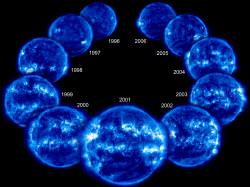On December 2
nd
, 1995 a large joint ESA and NASA mission was launched to gain an insight to the dynamics of the Sun and its relationship with the space between the planets. 12 years on, the
Solar and Heliospheric Observatory
(
SoHO
) continues to witness some of the largest explosions ever seen in the solar system, observes beautiful magnetic coronal arcs reach out into space and tracks comets as they fall to a fiery death. In the line of duty,
SoHO
even suffered a
near-fatal shutdown
(in 1998). As far as astronomy goes, this is a tough assignment.
By the end of 1996,
SoHO
had arrived at the First Lagrange Point between the Earth and the Sun (a gravitationally stable position balanced by the masses of the Sun and Earth, about 1.5 million km away) and orbits this silent outpost to this day. It began to transmit data at "solar minimum", a period of time at the beginning of the Solar Cycle, where sunspots are few and solar activity is low, and continues toward the upcoming solar minimum after the exciting firworks of the last "solar maximum". This gives physicists another chance to observe the majority of a Solar Cycle with a single observatory (the previous long-lasting mission was the Japanese
Yohkoh satellite
from 1991-2001).
On board this ambitious observatory, 11 instruments constantly gaze at the Sun, observing everything from solar oscillations (“Sun Quakes�), coronal loops, flares, CMEs and the solar wind; just about everything the Sun does.
SoHO
has become an indispensable mission for helping us to understand how the Sun influences the environment around our planet and how this generates the potentially dangerous “
Space Weather
�.
The
SoHO mission site
confidently states that
SoHO
will remain in operation far into the next Solar Cycle. I hope this is the case as the new
Hinode
and
STEREO
probes will be good company for this historic mission.
Source:
NASA News Release
 Universe Today
Universe Today
